/documentations/python_libraries/matplotlib/
Interactive Plotting
It can be tedious to blindly create a plot in the python repl. The command pyplot.ion() enables interactive mode. In interactive mode each command has immediate effect on the screen. With pyplot.ioff() the interactive mode is turned off.
import matplotlib.pyplot as plt plt.ion() plt.subplot(1,1,1) plt.plot([1,2,3])
More information at:
Examples
Images
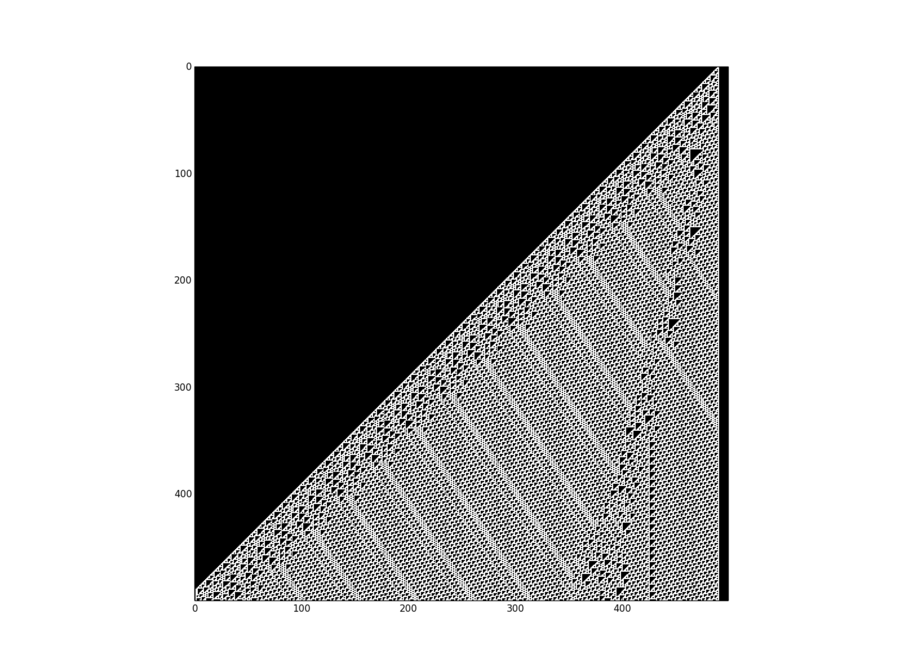
##################################################################### # Generate an image and pyplot.show it # # generate and plot a cellular automaton run # (Rule 110: https://en.wikipedia.org/wiki/Rule_of_110) ############################## # Import libraries import matplotlib.pyplot as plt import numpy as np ############################## # Initialize image variable # Dimension of the image dim_row = 500; dim_col = 510 # An image is a numpy.array for matplotlib img = np.zeros((dim_row, dim_col)) ############################## # Run Rule 110 # Set first cell alive img[0,dim_col-10] = 1 # Function computing next cell (Rule 110) def next_cell(cs): c = cs[1] + cs[2] if 1 < c: c = 1 - cs[0] return c # Let the cells evolve for i in xrange(dim_row-1): for j in xrange(1,dim_col-1): img[i+1,j] = next_cell(img[i,j-1:j+2]) ############################## # Plotting # Plot the cells imgplot = plt.imshow(img) # We wont to see pixels imgplot.set_interpolation('nearest') # Rule 110 shuld be black and white imgplot.set_cmap('bone') # Let's see plt.show()
More information about image handling with Matplotlib at:
Birthday Problem
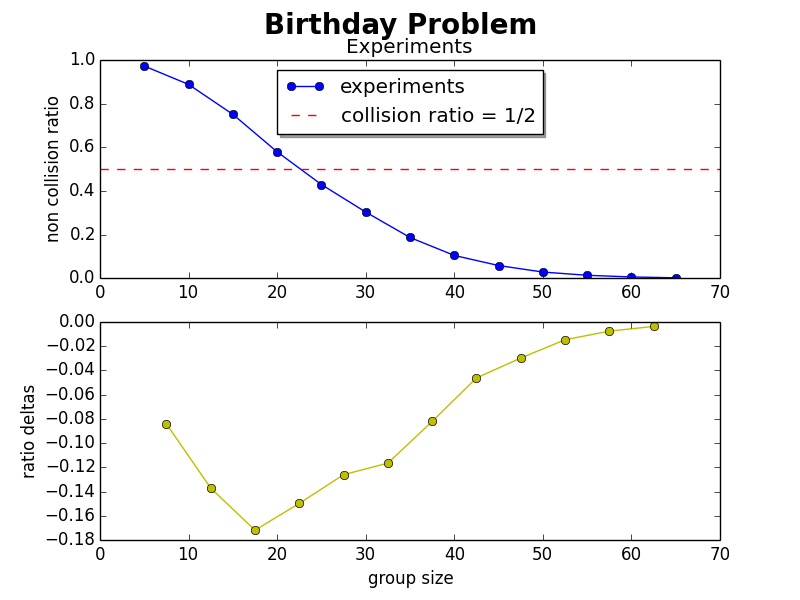
############################################################################## # Some plots of the birthday problem (see MAT101 Summary Week 3) # Group size versus non collision ratio ############################## # Import libraries import matplotlib.pyplot as plt from birthday import birthday_experiment ############################## # Set up birthday experiments number_groups = 10**4 size_min = 5; size_max = 65; delta = 5 group_sizes = range(size_min, size_max+delta, delta) ############################## # Do the experiments experiments = [] print 'Group sizes: ', group_sizes for size in group_sizes: # Display some status print 'group size: ', size experiments.append(birthday_experiment(size, number_groups)) ############################## # Plots fig = plt.figure(1) fig.suptitle('Birthday Problem', fontsize=20, fontweight='bold') # Two axes with common x-axis # The first plot shows the experiment results ax1 = fig.add_subplot(2,1,1) ax1.plot(group_sizes, experiments, 'o-', label='experiments') # A line showing the 1/2 collision ratio ax1.axhline(.5, color= 'red', linestyle='--',\ label='collision ratio = 1/2') # Title and legend ax1.set_title('Experiments') ax1.set_ylabel('non collision ratio') ax1.legend(loc='upper center', shadow=True) # The second plot shows the deltas in the experiment results. # The two plots share the x-axis: "sharex=ax1" ax2 = fig.add_subplot(2,1,2, sharex=ax1) ax2.plot([g+delta/2. for g in group_sizes[0:-1]],\ [experiments[i]-experiments[i-1] \ for i in range(1,len(experiments))], 'y-o') # Labels ax2.set_xlabel('group size') ax2.set_ylabel('ratio deltas') # Let's see plt.show() ############################################################################## # This code wraps up the birthday experiment in a function # Original code from the MAT101 Summary week 3 # Here is the dedication from the original file: # Today is 25.09.2013, my birthday. # This example file is dedicated to my friends Andreas and Catheline, and # their daughter who might or might not be born at this moment... # She is very close, but she has only a few hours left if she wants to # discover our world today, on the same date as me :-) # Paul import random def birthday_experiment(group_size, number_groups): """ Computes repeatedly the birthday experiment and returns the amount of runs without collision. group_size: group size used for each experiment number_groups: amount of experiments returns: #(experiments without collision)/#(experiments) """ without_collision = 0 for group_id in range(number_groups): birthdays = [] for person in range(group_size): birthday = random.randint(1, 365) if birthday in birthdays: break else: birthdays.append(birthday) else: without_collision += 1 return float(without_collision)/number_groups
Artist Components
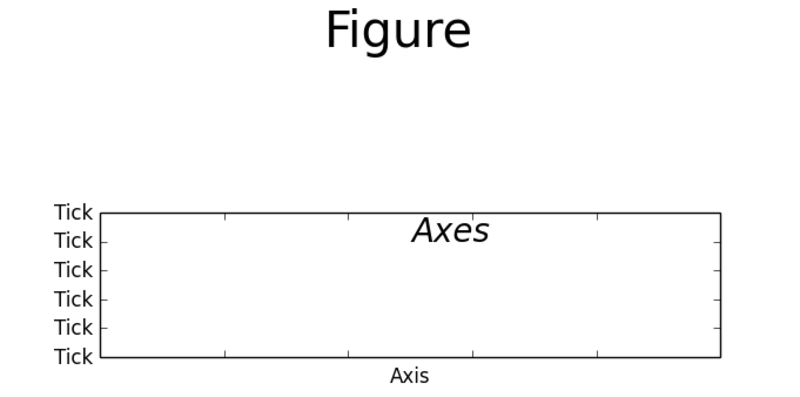
############################################################################## # Label the artist elements import matplotlib.pyplot as plt ############################# # Figure # Instantiate fig = plt.figure("Artist Elements") # Add component name as subtitle fig.suptitle('Figure', fontsize=30) ############################# # Axes # Instantiate ax = fig.add_subplot(212) # Add component name as text ax.text(0.5, 0.8, 'Axes', fontsize=20, style='italic') ############################# # Axis # Get x/y-axis objects xaxis = ax.xaxis yaxis = ax.yaxis # Get x-axis label label = xaxis.get_label() # Set x-axis label label.set_text('Axis') ############################# # Tick # Import ticker module import matplotlib.ticker as ticker # Set y-axis tick labels formatter = ticker.FormatStrFormatter('Tick') yaxis.set_major_formatter(formatter) # Disable xaxis tick labels ticks = xaxis.get_major_ticks() for t in ticks: t.label1On = False t.label2On = False # Let's see plt.show()
More information at:
Animation
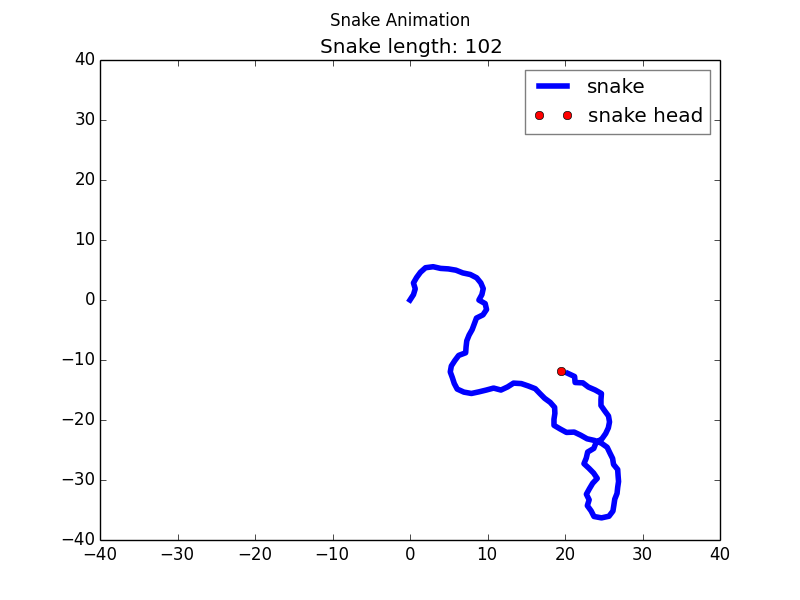
"""Snake animation as a matplotlib.animation example""" import matplotlib.pyplot as plt import matplotlib.animation as animation import numpy as np import random ############################# # Helper functions def limit_cage(position, cage_size): '''Limits position to be inside the cage''' return min(max(-cage_size+.5, position), cage_size-.5) def snake_step(pos_x, pos_y, snake): '''Coumputes next head position''' snake['speed_angle'] += (random.gauss(0, .5)) pos_x += np.sin(snake['speed_angle']) pos_y += np.cos(snake['speed_angle']) new_pos_x = limit_cage(pos_x, snake['cage_size']) new_pos_y = limit_cage(pos_y, snake['cage_size']) if pos_x != new_pos_x or pos_y != new_pos_y: snake['speed_angle'] += np.pi/2. return new_pos_x, new_pos_y def update(num, snake): '''Computes next frame''' # Get snake head position snake_head_x = snake['head'].get_xdata()[0] snake_head_y = snake['head'].get_ydata()[0] # Add snake head point to snake body snake['body'].set_xdata(np.append(snake['body'].get_xdata(), snake_head_x)) snake['body'].set_ydata(np.append(snake['body'].get_ydata(), snake_head_y)) # Generate next snake head position snake_head_x, snake_head_y = snake_step(snake_head_x, snake_head_y, snake) snake['head'].set_xdata([snake_head_x]) snake['head'].set_ydata([snake_head_y]) # Update the title ax1.set_title("Snake length: "+str(num)) ############################# # Setup the figure fig = plt.figure() fig.suptitle("Snake Animation") # Just one plotting area ax1 = fig.add_subplot(1, 1, 1) # The plot range cage_size = 40 plt.xlim(-cage_size, cage_size) plt.ylim(-cage_size, cage_size) # Snake body snake_body, = ax1.plot([], [], 'b', label='snake', linewidth=4) # Snake head snake_head, = ax1.plot([0.0], [0.0], 'ro', label='snake head') # Legend leg = ax1.legend() leg.get_frame().set_alpha(0.5) # The snake as dictionary snake = {'head': snake_head, \ 'body': snake_body, \ 'speed_angle': 0, \ 'cage_size': cage_size} # Generates the animation ani = animation.FuncAnimation(fig, \ update, \ interval=50, \ fargs=[snake], \ blit=False, \ repeat=False) #ani.save('mci_plot.avi', dpi=180) # matplotlib version 1.3.1 plt.show()
More information at:
- http://matplotlib.org/api/animation_api.html?highlight=animation
Combinatorics
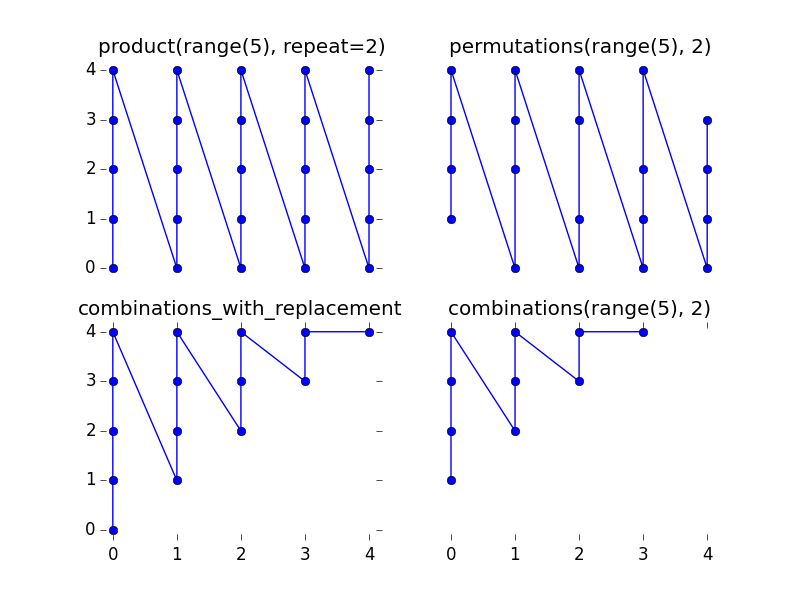
import itertools as it import matplotlib.pyplot as plt n = 5 fig = plt.figure() ax1 = fig.add_subplot(2,2,1, title="product(range("+str(n)+"), repeat=2)") plt.plot(*it.izip(*it.product(range(n), repeat=2)), marker='o') ax2 = fig.add_subplot(2,2,2, sharex=ax1, sharey=ax1, title="permutations(range("+str(n)+"), 2)") plt.plot(*it.izip(*it.permutations(range(n), 2)), marker='o') ax3 = fig.add_subplot(2,2,3, sharex=ax1, sharey=ax1, title="combinations_with_replacement") plt.plot(*it.izip(*it.combinations_with_replacement(range(n), 2)), marker='o') ax4 = fig.add_subplot(2,2,4, sharex=ax1, sharey=ax1, title="combinations(range("+str(n)+"), 2)") plt.plot(*it.izip(*it.combinations(range(n), 2)), marker='o') ax1.set_xlim(-.2, n-1+.2) ax1.set_ylim(-.2, n-1+.2) ax1.set_frame_on(False) ax2.set_frame_on(False) ax3.set_frame_on(False) ax4.set_frame_on(False) ax1.axes.get_xaxis().set_visible(False) ax2.axes.get_xaxis().set_visible(False) ax2.axes.get_yaxis().set_visible(False) ax4.axes.get_yaxis().set_visible(False) plt.show()
More information at: